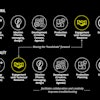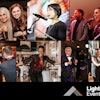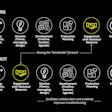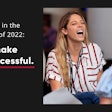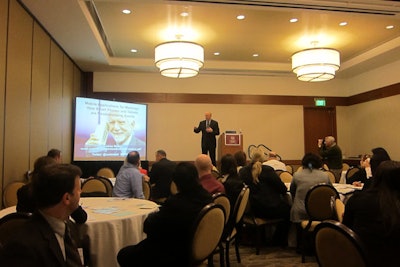
At Meeting Professionals International Southern California Chapter's "EdCon" industry powwow, education sessions further explored some subjects discussed at various recent meeting-industry shows, including IMEX America in Las Vegas in October and P.C.M.A.’s Convening Leaders in San Diego in January. Among those hot industry topics at the Sheraton Fairplex Hotel & Conference Center on Tuesday: mobile technology and environmentally friendly meetings.
Speaking in a session about smartphone apps and their impact on meetings and events, Corbin Ball Associates' C.E.O. Corbin Ball, a meeting and trade show technology consultant, began by telling the assembled crowd a twist on the boilerplate cell phone warning: “Keep your phones out. Use them for fact checking, for taking notes. Mobile technology is moving into the meeting space and changing how we do business.”
He said the industry has “crossed the chasm between early adopters to the early majority” in terms of using smartphone apps for event programs. For instance, he said, M.P.I.’s "Cascadia" conference used an app, but not a paper program. “In a year’s time, if you don’t have a mobile app for your event, people are going to be asking why are you are behind the times.”
The utility of apps comes first from what Ball described as their “Swiss army knife-like” utility. They can be conference programs, social media tools to proliferate the event’s message (40 percent of tweets come from mobile devices, he said), electronic ticketing tools, and local-area information providers. They also eliminate course notes and brochures and, of course, cut down on signage that may be of dubious utility itself. “I’d be standing in front of a sign that said ‘Registration,’ and people would ask me, ‘Where’s registration?’ People don’t read signs.”
Among the meeting apps he recommended for their multifunctional qualities are apps available through developers at the likes of quickmobile.com and crowdcompass.com. Bump allows attendees to share contact info by simply bumping their phones, so that “it’s as easy for me as an attendee to share my contact info electronically as it has been for exhibitors to get that info at their booths.” Perhaps most impressive to the assembled audience at the session was Ball’s discussion of an app called Word Lens (available through the iTunes store), which is an augmented-reality program that translates languages visually, right on the spot, with obvious benefits for the likes of signage, menus, and general communication at foreign shows or shows with international attendees.
In addition to general discussion of the benefits of QR codes and near-field communication (which in part, he said, can serve as micropayment processors at events for purposes like ticketing), and audience-polling apps, Ball celebrated smartphone app technology for assistance with overall meeting logistics like its ability to replace a meeting planner’s massive telltale binder. “A piece of paper,” he said, "is a white flag of inefficiency."
Another topic of continued importance to the meeting industry is implementing sustainable practices. Katherine Manfredi, senior director of strategic event management and C.S.R. for Conference Partners Inc., discussed the new standards available to planners, created through a partnership of the Convention Industry Council's APEX initiative and A.S.T.M. International. The system of nine standards includes meeting areas like food and beverage, on-site offices, transportation, venues, and others through the entire event cycle. And she reinforced that many are cost neutral, a point often asserted during meeting industry confabs, but which carries lingering doubt among some planners attempting to implement green strategies and get buy-in from their C-level suites.
“In my experience in doing a green meeting, I frequently will keep the budget the way it is or scale it back,” Manfredi said. “People think there’s a lot of cost attached. Yes, there are sometimes cost investments—for instance, a hotel putting in a new H-VAC system—but there’s a lot that’s cost saving. Things like installing motion sensors get paid back very quickly. And sometimes it’s a balancing act: This will cost over here, so we’ll save over there. [Over all] the cost benefit is tremendous.”
Manfredi discussed ways to support sustainable meeting practices, like relying on natural light to the extent possible, reducing or eliminating linens, and setting meeting tables with pitchers instead of prepoured water glasses, which may never be touched by attendees. She shows examples of products made from cornstarch, corn plastic, potato starch, sugar cane, and bamboo. And she cited a figure from Classic Party Green Zone, which claims it can wash 14,000 glasses and use less energy than needed to make and dispose of one plastic cup.
She also advised making smart and consistent choices throughout a meeting: “For instance, you don’t want to be serving organic veggies on Styrofoam plates. Kind of a mixed message.” To that end, she discussed “greenwashing,” the term used to describe false or misleading claims about the overall environmentally friendliness of a meeting or venue. "For instance, if [a hotel has] only 50 percent vacancy and they make the claim that they saved 50 percent on electricity," she said. "Measure your results and cost savings so you can be clear you’re not doing that.”
And as for that potentially difficult talk with the client or other stakeholders in meeting decision-making, Manfredi said guests might be pleasantly surprised: “There’s a lot of things you can do at green meetings that your delegates appreciate, because they are already doing those things at home.”

